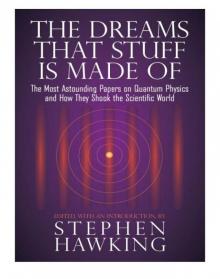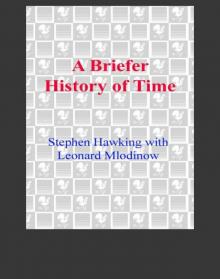- Home
- Stephen Hawking
A Stubbornly Persistent Illusion Page 8
A Stubbornly Persistent Illusion Read online
Page 8
The mathematical importance of this tensor is as follows: If the continuum is of such a nature that there is a co-ordinate system with reference to which the gμv are constants, then all the vanish. If we choose any new system of coordinates in place of the original ones, the gμv referred thereto will not be constants, but in consequence of its tensor nature, the transformed components of will still vanish in the new system. Thus the vanishing of the Riemann tensor is a necessary condition that, by an appropriate choice of the system of reference, the gμv may be constants. In our problem this corresponds to the case in which,* with a suitable choice of the system of reference, the special theory of relativity holds good for a finite region of the continuum.
Contracting (43) with respect to the indices τ and ρ we obtain the covariant tensor of second rank
Note on the Choice of Co-ordinates.—It has already been observed in § 8, in connexion with equation (18a), that the choice of co-ordinates may with advantage be made so that A glance at the equations obtained in the last two sections shows that by such a choice the laws of formation of tensors undergo an important simplification. This applies particularly to Gμv, the tensor just developed, which plays a fundamental part in the theory to be set forth. For this specialization of the choice of co-ordinates brings about the vanishing of Sμv, so that the tensor Gμv reduces to Rμv
On this account I shall hereafter give all relations in the simplified form which this specialization of the choice of co-ordinates brings with it. It will then be an easy matter to revert to the generally covariant equations, if this seems desirable in a special case.
C. THEORY OF THE GRAVITATIONAL FIELD
§ 13. EQUATIONS OF MOTION OF A MATERIAL POINT IN THE GRAVITATIONAL FIELD. EXPRESSION FOR THE FIELD-COMPONENTS OF GRAVITATION
A freely movable body not subjected to external forces moves, according to the special theory of relativity, in a straight line and uniformly. This is also the case, according to the general theory of relativity, for a part of four-dimensional space in which the system of co-ordinates K0, may be, and is, so chosen that they have the special constant values given in (4).
If we consider precisely this movement from any chosen system of co-ordinates K1, the body, observed from K1, moves, according to the considerations in § 2, in a gravitational field. The law of motion with respect to K1 results without difficulty from the following consideration. With respect to K0 the law of motion corresponds to a four-dimensional straight line, i.e. to a geodetic line. Now since the geodetic line is defined independently of the system of reference, its equations will also be the equation of motion of the material point with respect to K1. If we set
the equation of the motion of the point with respect to K1, becomes
We now make the assumption, which readily suggests itself, that this covariant system of equations also defines the motion of the point in the gravitational field in the case when there is no system of reference K0, with respect to which the special theory of relativity holds good in a finite region. We have all the more justification for this assumption as (46) contains only first derivatives of the gμv, between which even in the special case of the existence of K0, no relations subsist.*
If the vanish, then the point moves uniformly in a straight line. These quantities therefore condition the deviation of the motion from uniformity. They are the components of the gravitational field.
§ 14. THE FIELD EQUATIONS OF GRAVITATION IN THE ABSENCE OF MATTER
We make a distinction hereafter between “gravitational field” and “matter” in this way, that we denote everything but the gravitational field as “matter.” Our use of the word therefore includes not only matter in the ordinary sense, but the electromagnetic field as well.
Our next task is to find the field equations of gravitation in the absence of matter. Here we again apply the method employed in the preceding paragraph in formulating the equations of motion of the material point. A special case in which the required equations must in any case be satisfied is that of the special theory of relativity, in which the gμv have certain constant values. Let this be the case in a certain finite space in relation to a definite system of co-ordinates K0. Relatively to this system all the components of the Riemann tensor , defined in (43), vanish. For the space under consideration they then vanish, also in any other system of co-ordinates.
Thus the required equations of the matter-free gravitational field must in any case be satisfied if all vanish. But this condition goes too far. For it is clear that, e.g., the gravitational field generated by a material point in its environment certainly cannot be “transformed away” by any choice of the system of co-ordinates, i.e. it cannot be transformed to the case of constant gμv.
This prompts us to require for the matter-free gravitational field that the symmetrical tensor Gμv, derived from the tensor , shall vanish. Thus we obtain ten equations for the ten quantities gμv, which are satisfied in the special case of the vanishing of all . With the choice which we have made of a system of co-ordinates, and taking (44) into consideration, the equations for the matter-free field are
It must be pointed out that there is only a minimum of arbitrariness in the choice of these equations. For besides Gμv there is no tensor of second rank which is formed from the gμv and its derivatives, contains no derivations higher than second, and is linear in these derivatives.*
These equations, which proceed, by the method of pure mathematics, from the requirement of the general theory of relativity, give us, in combination with the equations of motion (46), to a first approximation Newton’s law of attraction, and to a second approximation the explanation of the motion of the perihelion of the planet Mercury discovered by Leverrier (as it remains after corrections for perturbation have been made). These facts must, in my opinion, be taken as a convincing proof of the correctness of the theory.
§ 15. THE HAMILTONIAN FUNCTION FOR THE GRAVITATIONAL FIELD. LAWS OF MOMENTUM AND ENERGY
To show that the field equations correspond to the laws of momentum and energy, it is most convenient to write them in the following Hamiltonian form:—
where, on the boundary of the finite four-dimensional region of integration which we have in view, the variations vanish.
We first have to show that the form (47a) is equivalent to the equations (47). For this purpose we regard H as a function of the gμv and the .
Then in the first place
But
The terms arising from the last two terms in round brackets are of different sign, and result from each other (since the denomination of the summation indices is immaterial) through interchange of the indices μ and β. They cancel each other in the expression for δH, because they are multiplied by the quantity , which is symmetrical with respect to the indices μ and β. Thus there remains only the first term in round brackets to be considered, so that, taking (31) into account, we obtain
Thus
Carrying out the variation in (47a), we get in the first place
which, on account of (48), agrees with (47), as was to be proved.
If we multiply (47b) by , then because
and, consequently,
we obtain the equation
or*
where, on account of (48), the second equation of (47), and (34)
It is to be noticed that is not a tensor; on the other hand (49) applies to all systems of co-ordinates for which This equation expresses the law of conservation of momentum and of energy for the gravitational field. Actually the integration of this equation over a three-dimensional volume V yields the four equations
where l, m, n denote the direction-cosines of direction of the inward drawn normal at the element dS of the bounding surface (in the sense of Euclidean geometry). We recognize in this the expression of the laws of conservation in their usual form. The quantities we call the “energy components” of the gravitational field.
I will now give equations (47) in a third form, which is particularly useful for a vivid grasp of our sub
ject. By multiplication of the field equations (47) by gvσ these are obtained in the “mixed” form. Note that
which quantity, by reason of (34), is equal to
or (with different symbols for the summation indices)
The third term of this expression cancels with the one arising from the second term of the field equations (47); using relation (50), the second term may be written
where . Thus instead of equations (47) we obtain
§ 16. THE GENERAL FORM OF THE FIELD EQUATIONS OF GRAVITATION
The field equations for matter-free space formulated in § 15 are to be compared with the field equation
of Newton’s theory. We require the equation corresponding to Poisson’s equation
where ρ denotes the density of matter.
The special theory of relativity has led to the conclusion that inert mass is nothing more or less than energy, which finds its complete mathematical expression in a symmetrical tensor of second rank, the energy-tensor. Thus in the general theory of relativity we must introduce a corresponding energy-tensor of matter , which, like the energy-components tσ [equations (49) and (50)] of the gravitational field, will have mixed character, but will pertain to a symmetrical covariant tensor.*
The system of equation (51) shows how this energy-tensor (corresponding to the density ρ in Poisson’s equation) is to be introduced into the field equations of gravitation. For if we consider a complete system (e.g. the solar system), the total mass of the system, and therefore its total gravitating action as well, will depend on the total energy of the system, and therefore on the ponderable energy together with the gravitational energy. This will allow itself to be expressed by introducing into (51), in place of the energy-components of the gravitational field alone, the sums of the energy-components of matter and of gravitational field. Thus instead of (51) we obtain the tensor equation
where we have set (Laue’s scalar). These are the required general field equations of gravitation in mixed form. Working back from these, we have in place of (47)
It must be admitted that this introduction of the energy-tensor of matter is not justified by the relativity postulate alone. For this reason we have here deduced it from the requirement that the energy of the gravitational field shall act gravitatively in the same way as any other kind of energy. But the strongest reason for the choice of these equations lies in their consequence, that the equations of conservation of momentum and energy, corresponding exactly to equations (49) and (49a), hold good for the components of the total energy. This will be shown in § 17.
§ 17. THE LAWS OF CONSERVATION IN THE GENERAL CASE
Equation (52) may readily be transformed so that the second term on the right-hand side vanishes. Contract (52) with respect to the indices μ and σ, and after multiplying the resulting equation by , subtract it from equation (52). This gives
On this equation we perform the operation ∂/∂xσ. We have
The first and third terms of the round brackets yield contributions which cancel one another, as may be seen by interchanging, in the contribution of the third term, the summation indices α and σ on the one hand, and β and λ on the other. The second term may be remodelled by (31), so that we have
The second term on the left-hand side of (52a) yields in the first place
or
With the choice of co-ordinates which we have made, the term deriving from the last term in round brackets disappears by reason of (29). The other two may be combined, and together, by (31), they give
so that in consideration of (54), we have the identity
From (55) and (52a), it follows that
Thus it results from our field equations of gravitation that the laws of conservation of momentum and energy are satisfied. This may be seen most easily from the consideration which leads to equation (49a); except that here, instead of the energy components tσ of the gravitational field, we have to introduce the totality of the energy components of matter and gravitational field.
§ 18. THE LAWS OF MOMENTUM AND ENERGY FOR MATTER, AS A CONSEQUENCE OF THE FIELD EQUATIONS
Multiplying (53) by ∂gμv/∂xσ, we obtain, by the method adopted in § 15, in view of the vanishing of
the equation
or, in view of (56),
Comparison with (41b) shows that with the choice of system of co-ordinates which we have made, this equation predicates nothing more or less than the vanishing of divergence of the material energy-tensor. Physically, the occurrence of the second term on the left-hand side shows that laws of conservation of momentum and energy do not apply in the strict sense for matter alone, or else that they apply only when the gμv are constant, i.e. when the field intensities of gravitation vanish. This second term is an expression for momentum, and for energy, as transferred per unit of volume and time from the gravitational field to matter. This is brought out still more clearly by re-writing (57) in the sense of (41) as
The right side expresses the energetic effect of the gravitational field on matter.
Thus the field equations of gravitation contain four conditions which govern the course of material phenomena. They give the equations of material phenomena completely, if the latter is capable of being characterized by four differential equations independent of one another.*
D. MATERIAL PHENOMENA
The mathematical aids developed in part B enable us forthwith to generalize the physical laws of matter (hydrodynamics, Maxwell’s electrodynamics), as they are formulated in the special theory of relativity, so that they will fit in with the general theory of relativity. When this is done, the general principle of relativity does not indeed afford us a further limitation of possibilities; but it makes us acquainted with the influence of the gravitational field on all processes, without our having to introduce any new hypothesis whatever.
Hence it comes about that it is not necessary to introduce definite assumptions as to the physical nature of matter (in the narrower sense). In particular it may remain an open question whether the theory of the electromagnetic field in conjunction with that of the gravitational field furnishes a sufficient basis for the theory of matter or not. The general postulate of relativity is unable on principle to tell us anything about this. It must remain to be seen, during the working out of the theory, whether electromagnetics and the doctrine of gravitation are able in collaboration to perform what the former by itself is unable to do.
§ 19. EULER’S EQUATIONS FOR A FRICTIONLESS ADIABATIC FLUID
Let p and ρ be two scalars, the former of which we call the “pressure,” the latter the “density” of a fluid; and let an equation subsist between them. Let the contravariant symmetrical tensor
be the contravariant energy-tensor of the fluid. To it belongs the covariant tensor
as well as the mixed tensor*
Inserting the right-hand side of (58b) in (57a), we obtain the Eulerian hydrodynamical equations of the general theory of relativity. They give, in theory, a complete solution of the problem of motion, since the four equations (57a), together with the given equation between p and ρ, and the equation
are sufficient, gαβ being given, to define the six unknowns
If the gμv are also unknown, the equations (53) are brought in. These are eleven equations for defining the ten functions gμv, so that these functions appear over-defined. We must remember, however, that the equations (57a) are already contained in the equations (53), so that the latter represent only seven independent equations. There is good reason for this lack of definition, in that the wide freedom of the choice of co-ordinates causes the problem to remain mathematically undefined to such a degree that three of the functions of space may be chosen at will.*
§ 20. MAXWELL’S ELECTROMAGNETIC FIELD EQUATIONS FOR FREE SPACE
Let ϕv be the components of a covariant vector—the electromagnetic potential vector. From them we form, in accordance with (36), the components Fρσ of the covariant six-vector of the electromagnetic field, in accordance with the system of equations
It follows from (59) that the system of equations
is satisfied, its left side being, by (37), an antisymmetrical tensor of the third rank. System (60) thus contains essentially four equations which are written out as follows:—
This system corresponds to the second of Maxwell’s systems of equations. We recognize this at once by setting
Then in place of (60a) we may set, in the usual notation of three-dimensional vector analysis,
We obtain Maxwell’s first system by generalizing the form given by Minkowski. We introduce the contravariant six-vector associated with Fαβ
and also the contravariant vector Jμ of the density of the electric current. Then, taking (40) into consideration, the following equations will be invariant for any substitution whose invariant is unity (in agreement with the chosen coordinates):—
Let

 The Grand Design
The Grand Design A Brief History of Time
A Brief History of Time The Dreams That Stuff is Made of
The Dreams That Stuff is Made of My Brief History
My Brief History A Briefer History of Time
A Briefer History of Time A Stubbornly Persistent Illusion
A Stubbornly Persistent Illusion George and the Blue Moon
George and the Blue Moon George and the Unbreakable Code
George and the Unbreakable Code Brief Answers to the Big Questions
Brief Answers to the Big Questions George's Secret Key to the Universe
George's Secret Key to the Universe